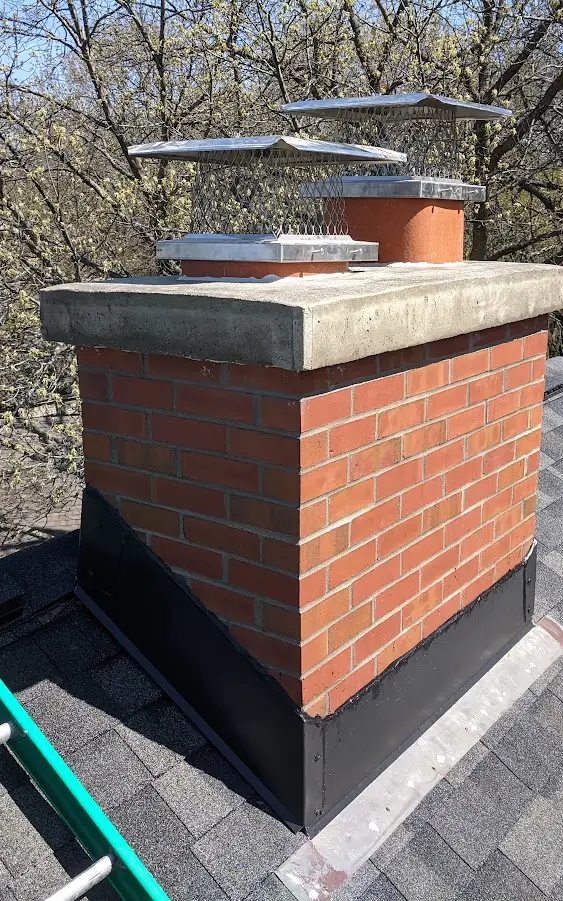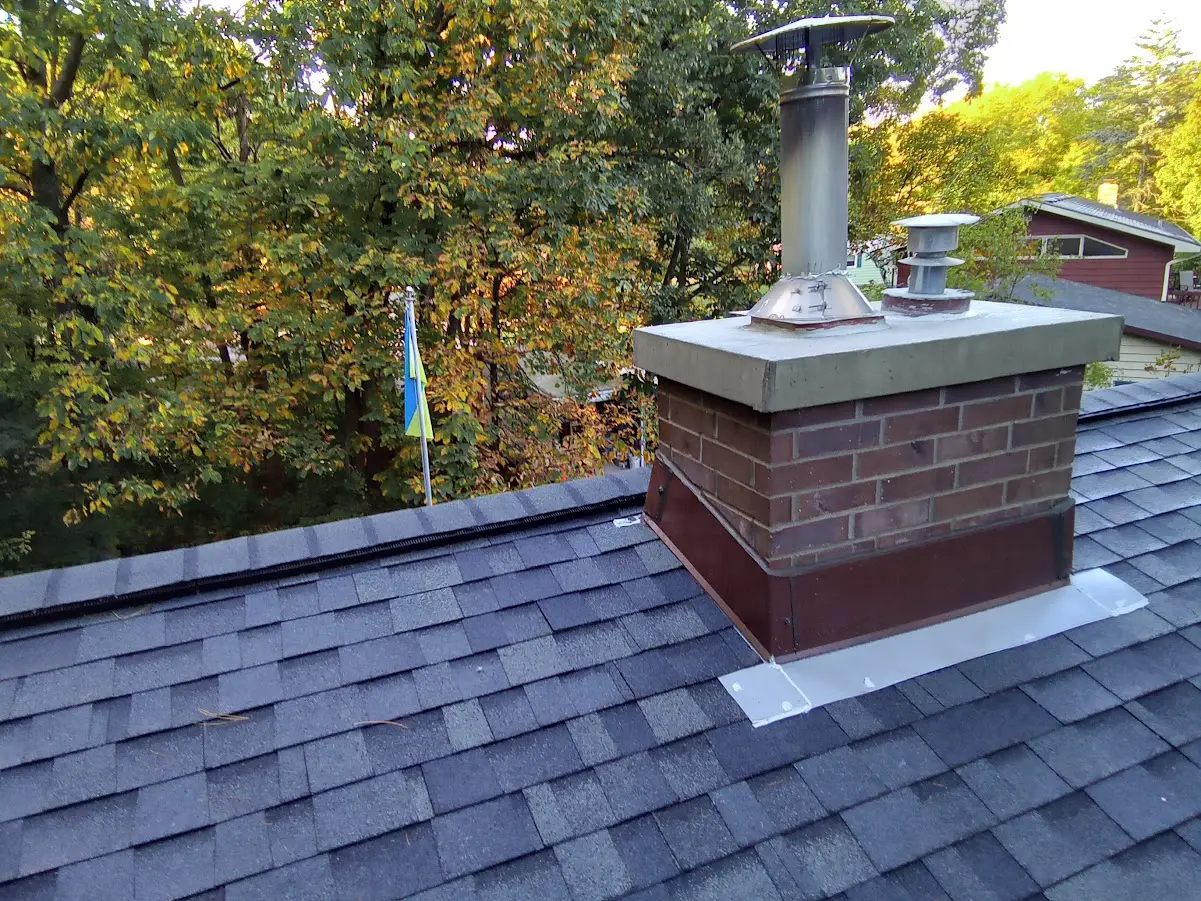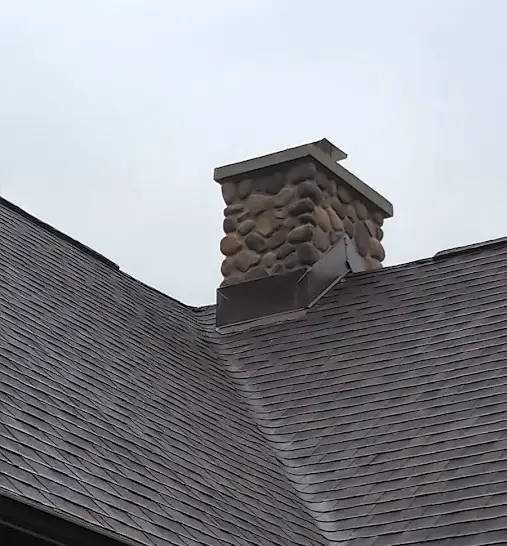For Chimney Flashing & Cricket Repair or Replacement in Madison, Trust Our Pros
Few things are worse than a leaking chimney. Even more annoying is that with so many potential entry points for water to seep in, diagnosing the root cause of the issue can be quite the challenge. In many cases, old, improperly installed, or deteriorated chimney flashing is to blame.
The good news is that the dedicated team of Chimney Safety Institute of America (CSIA) certified pros here at Hansen & Sons Chimney & Fireplace have the tools and training to help. Whether your flashing is in desperate need of repair or is missing altogether, we have long-lasting solutions.
Could your chimney stack benefit from a cricket? We can help with that, too. For all your chimney leak concerns near Madison, WI, call Hansen & Sons – the oldest chimney and fireplace service and repair company in the area. With over 71+ years of service in this industry, you can trust that when you work with us, you’re in good hands.
Learn more by booking an appointment online or give us a call at 608-466-4185 today.
What Is Chimney Flashing?
Constructed from sheet metal, chimney flashing is installed between the base of your structure and the roof. Designed to create a watertight seal where the chimney joins the roof, when damaged, deteriorated, or altogether missing, the flashing can cause a lot of issues for both your chimney and your home.
Because water control is chimney flashing’s primary job, it accounts for the natural movement and shifting that occurs between the roof of your home and the protruding chimney stack. Since your chimney and roof are made from different materials, they expand and contract at varying rates due to temperature fluctuations. This movement can create gaps around the chimney, which invites water to seep into your home through the ceiling or into the base of the chimney itself.
Chimney flashing addresses this issue. The specific type, material, and installation method may differ depending on the location, but the overall purpose remains consistent: to seal these gaps and prevent water leakage from rain, melting snow, and other forms of precipitation.
How Does Flashing Work?
To achieve that perfect, watertight seal, chimney flashing is installed in three different types:
- Step Flashing: Utilizing shingle-like metal pieces folded into an “L,” this is the first layer of flashing and is strategically placed under the roof shingles and directly against the whole base of your chimney.
- Counter Flashing (sometimes called cap flashing): Acting as the secondary level of protection and insulation, counter flashing is installed directly on top of step flashing and is inserted into the bricks themselves.
- Base Flashing: Finally, there is base flashing that is installed around the whole base of the chimney stack and ensures that the seal is reinforced and impenetrable.
All of these layers work together to protect your whole home from extensive water damage. Even missing one of these different types can lead to a leaky chimney. If you’re suffering from water damage to your home or chimney, your flashing might be the culprit. Give the pros at Hansen & Sons a call to schedule a time for us to come out and take a look. You can book right here online, or give us a call at 608-466-4185.
What Materials Are Usually Used for Chimney Flashing?
Similar to other metal-based components of a chimney system (things like the flue liner, chimney cap, chase cover, etc.), flashing is usually constructed from one of the following:
- Aluminum: Lightweight and easily formed, aluminum is a popular choice for its lower price point. But, because it is a cheaper material, aluminum flashing may face premature degradation.
- Copper: Malleable like aluminum, copper is a bit pricier and offers a distinct aesthetic that changes color over time due to oxidation. Many homeowners choose it for the curb appeal and the beauty of its gradual aging over the years.
- Steel: Perhaps the most popular of all, steel is known for its strength and durability, but also its versatility. Not only is it visually appealing, it’s also quite flexible and resistant to rust and corrosion if properly galvanized.
Questions about what material might be the best fit for your home? We’d love to help you weigh your options and pick something that works for you. Call 608-466-4185 or fill out this contact form through our website to get started today.


What Is a Chimney Cricket? When Is It Required?
Also known by the names “roof cricket” and “chimney saddle,” a chimney cricket is a small, peaked structure installed at the back of a chimney (closest to the apex) where it intersects the roof. Its purpose is to divert any water out and away from the chimney stack so that it cannot pool and cause damage to either the roof or the base of the chimney.
Chimney crickets are usually required when the chimney is over 30 inches wide, but there are some other scenarios where having one installed is recommended:
- Particularly Steep Roofs: On roofs with a steep slope, water tends to run down quickly and can pool behind the chimney if there’s no cricket to divert it.
- Multiple and Converging Roof Valleys: If your roof has multiple valleys that converge near the chimney, a cricket helps ensure water collecting in these valleys doesn’t get trapped behind the chimney.
- Certain Roofing Materials: Some roofing materials, like metal, can be more prone to water pooling behind the chimney compared to other materials. This is especially true if they’re installed incorrectly.
Building codes often include mandates for cricket installation to ensure proper drainage and promote longevity in both the chimney and roof.
Could your chimney benefit from the help of a cricket? Here at Hansen & Sons, our water damage chimney repair services are comprehensive. This means that we’ll take a look at your setup, investigate the flashing, and determine the next best steps to get everything back on track so you can get back to enjoying your appliance the way it was intended. To learn more, reach out to our dedicated experts.
Who Should I Call for Flashing Installation? A Roofer or a Chimney Technician?
That’s a great question. There can be confusion about who to call for chimney flashing repairs – a roofer or a chimney specialist. Here’s why choosing a qualified chimney technician is important:

- Specialized Knowledge: Chimney flashing, while connected to the roof, plays a crucial role in the chimney system’s integrity. A chimney technician has in-depth knowledge of flashing’s interaction with other chimney components and how to attach it properly so the structure can still breathe and function effectively.
- Comprehensive Assessment: A professional chimney specialist can assess the flashing issue within the context of the entire chimney system, identifying potential causes and recommending appropriate repairs that address the root problem.
- Experience With Chimney Materials: Chimney technicians understand the specific materials used in chimney construction and flashing, ensuring proper repairs that maintain the chimney’s overall health and safety.
While some roofers may be competent in flashing repair, a chimney technician brings a focused, streamlined expertise to the table. This specialized knowledge is critical in ensuring a long-lasting and effective repair that protects both your chimney and your home.
How Do I Know if My Chimney Flashing is Damaged?
Unfortunately, you don’t. Even with annual professional chimney inspections and cleanings, your flashing can still suffer from external damage or general deterioration. Here are some signs to watch out for:
- Water Stains: Look for water stains on the ceiling near your fireplace or on the walls surrounding the chimney. These indicate leaks that might be originating from the flashing, as opposed to another component or area like the chimney cap.
- Interior Leaks: If water is dripping or leaking inside your fireplace or stove, it’s a strong sign that the flashing is compromised.
- Chimney Discoloration: Discoloration throughout the structure’s brickwork is another clue that water is seeping in somewhere – especially if it’s concentrated toward the base of the chimney stack.
- Caulking Issues: Gaps, cracks, or other separations in the caulking between the flashing and the chimney allow water easy access to penetrate and subsequently infiltrate the entire system.
However, just because you notice any one of these signs doesn’t necessarily mean that the leak stems from an issue with the flashing. While it is certainly one of the most common areas prone to leaks, it is not the only. To preserve the health and longevity of your system, it’s important to stop using your fireplace until a professional can come out, assess the damage, and outline the best course of action forward. Reach out to our team to learn more.
Call Today To Book Your Chimney Flashing Repair Service with Hansen & Sons
Since 1953, Hansen & Sons Chimney & Fireplace has kept the greater Madison, WI area safe and warm with exceptional chimney and fireplace services. We’ve never met a leak we can’t patch or an issue we couldn’t solve and with over seven decades of industry experience, we’ve seen – and fixed – it all.
For expert chimney flashing replacement and chimney cricket installation near Madison, call the pros here at Hansen & Sons. We’re certain you won’t be disappointed. Get started today by filling out an appointment request form or give us a call at 608-466-4185.

Give your chimney structure the protection it deserves with a properly fitted chase cover. That’s what our chimney repair experts do!
